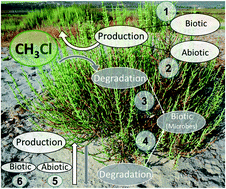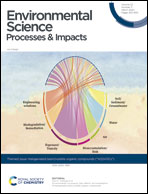Sources and sinks of chloromethane in a salt marsh ecosystem: constraints from concentration and stable isotope measurements of laboratory incubation experiments
Abstract
Chloromethane (CH3Cl) is the most abundant long-lived chlorinated organic compound in the atmosphere and contributes significantly to natural stratospheric ozone depletion. Salt marsh ecosystems including halophyte plants are a known source of atmospheric CH3Cl but estimates of their total global source strength are highly uncertain and knowledge of the major production and consumption processes in the atmosphere-halophyte-soil system is yet incomplete. In this study we investigated the halophyte plant, Salicornia europaea, and soil samples from a coastal salt marsh site in Sardinia/Italy for their potential to emit and consume CH3Cl and using flux measurements, stable isotope techniques and Arrhenius plots differentiated between biotic and abiotic processes. Our laboratory approach clearly shows that at least 6 different production and consumption processes are active in controlling atmospheric CH3Cl fluxes of a salt marsh ecosystem. CH3Cl release by dried plant and soil material was substantially higher than that from the fresh material at temperatures ranging from 20 to 70 °C. Results of Arrhenius plots helped to distinguish between biotic and abiotic formation processes in plants and soils. Biotic CH3Cl consumption rates were highest at 30 °C for plants and 50 °C for soils, and microbial uptake was higher in soils with higher organic matter content. Stable isotope techniques helped to distinguish between formation and degradation processes and also provided a deeper insight into potential methyl moiety donor compounds, such as S-adenosyl-L-methionine, S-methylmethionine and pectin, that might be involved in the abiotic and biotic CH3Cl production processes. Our results clearly indicate that cycling of CH3Cl in salt marsh ecosystems is a result of several biotic and abiotic processes occurring simultaneously in the atmosphere-plant-soil system. Important precursor compounds for biotic and abiotic CH3Cl formation might be methionine derivatives and pectin. All formation and degradation processes are temperature dependent and thus environmental changes might affect the strength of each source and sink within salt marsh ecosystems and thus considerably alter total fluxes of CH3Cl from salt marsh ecosystems to the atmosphere.

- This article is part of the themed collections: Geochemistry, SDG13: Climate Action – Ozone Depletion, Best Papers of 2020 from RSC’s Environmental Science journals, Best Papers 2020 – Environmental Science: Processes & Impacts and Halogenated (semi)volatile organic compounds (“X(S)VOCs”)


 Please wait while we load your content...
Please wait while we load your content...